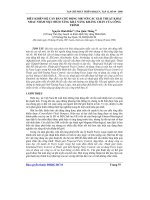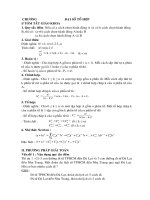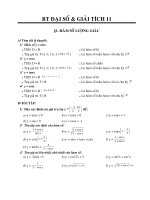MR cha10 contrastagents
Bạn đang xem bản rút gọn của tài liệu. Xem và tải ngay bản đầy đủ của tài liệu tại đây (5.88 MB, 62 trang )
MRI Contrast Agents
Jerry Allison Ph.D.
Chris Wright B.S.
Tom Lavin B.S.
Nathan Yanasak Ph.D.
Tom Hu Ph.D. MBA
December 12th, 2007
Outline
• Introduction to MR Contrast Agents
Exogenous
Paramagnetic Agents
Superparamagnetic Agents
Ferromagnetic Agents
Positive Contrast Agents
Negative Contrast Agents
Route of Administration
• Clinical Based MRI Contrast Agents/Examples
Outline
• Introduction to MR Contrast Agents
Exogenous
Paramagnetic Agents
Superparamagnetic Agents
Ferromagnetic Agents
Positive Contrast Agents
Negative Contrast Agents
Route of Administration
• Clinical Based MRI Contrast Agents/Examples
Contrast Agents
•
•
•
•
•
•
•
Exogenous
Paramagnetic Agents
Superparamagnetic Agents
Ferromagnetic Agents
Positive Contrast Agents
Negative Contrast Agents
Route of Administration
Contrast Agents
• Contrast agents are useful for detection of tumors, infection,
inflammation, infarction and lesions. Contrast agents alter T1,
T2, or T2* of various tissues, producing contrast.
• Barium and iodine compounds are used to enhance contrast in xray procedures. These compounds are sometimes referred to as
contrast “media” since their presence appears directly in the
images.
• MRI contrast is enhanced using contrast “agents” since the
contrast is not directly imaged but rather the effect that the
magnetic properties of the contrast agent has on the relaxation of
tissues is imaged.
Contrast Agents (Exogenous)
• A variety of paramagnetic, superparamagnetic and
ferromagnetic contrast agents can be administered i.v.,
orally or rectally to manipulate tissue contrast.
• Contrast agents are generally described by their magnetic
properties or contrast enhancement.
paramagnetic agents
ferromagnetic agents
superparamagnetic agents
Contrast Agents (Exogenous)
• Paramagnetic substances have positive magnetic susceptibility
due to the presence of one or more unpaired electrons:
Gd3+
7 unpaired electrons
Dy3+
5 unpaired electrons
Fe2+
5 unpaired electrons
Mn3+ 4 unpaired electrons
Contrast Agents (Exogenous)
• Ferromagnetic substances are solids with crystalline structures
that develop small magnetic domains. When placed in an
external magnetic field (B0), the multitude of magnetic domains
will align with the field and retain that magnetism when
removed from the Bo field.
Iron, Nickel and Cobalt have ferromagnetic properties.
Contrast Agents (Exogenous)
• Superparamagnetic substances are smaller solid particles each of
which develop a “single domain”.
Like ferromagnetic
substances, the domains align in the external magnetic field;
unlike ferromagnetic particles, the alignment disperses when
the paramagnetic substance is removed from the external field.
Magnetite Fe3O4 (i.v. or oral)
Contrast Agents
Positive contrast agents:
• Positive contrast agents cause hyperintensity on T1 weighted
images. The presence of a positive agent stimulates an increase
in spin flip transitions resulting in reduced T1 values and
increased brightness on T1 weighted images.
Contrast Agents: T1 Relaxation Time
(
M z (t ) = M 0 1 − e
− t / T1
)
Contrast Agents (Positive Contrast Agents)
Let’s examine the most common positive contrast agent:
Gd - DTPA
Gadolinium (Gd) is atomic number 64 and hence, has 64 electrons.
The electrons are distributed in shells as follows:
k
l
m
n
o
p
1
2
3
4
5
6
s
s p s p d s p d f
s p d s
2 2 6 2 6 10 2 6 10 7 2 6 1 2
Periodic Table
Contrast Agents
Positive contrast agents:
• There are seven different orbits in the 4f electron subshell, each
of which can hold up to two electrons (spin up & spin down or
clockwise & counterclockwise).
• In Gd, the seven electrons of the 4f subshell each occupy a
different orbit resulting in 7 unpaired electrons in the atom.
Each of the unpaired electrons has an electron magnetic moment
658 times larger than the nuclear magnetic moment of the
hydrogen proton.
Contrast Agents
Positive contrast agents:
• Gd is a toxic metal that binds to membranes, transport proteins,
enzymes, lung, liver, spleen and bone. Small amounts of
metallic Gd can cause liver necrosis. Gd is complexed in a
chelate and is rapidly cleared from the body via glomerular
filtration.
Contrast Agents
Positive contrast agents:
80% excretion by kidneys in 3 hours
98% in excreta in 1 week
• In Gd-DTPA, the toxic metal ion is complexed in a chelate
(lobster claw). The chelate is the N-methylglucamine salt of
diethylenetriamine pentaacetic acid. Chelation determines the
effect that the paramagnetic substance will have on proton
relaxation. The access of water molecules to the Gd ion is
determined by the structure and size of the chelation agent.
Contrast Agents
Positive contrast agents:
• The metal chelate complexes affect the net magnetic moment of
the contrast agent molecule.
Toxicity, solubility,
biodistribution, plasma residence time, elimination routes and
relaxivity properties of Gd chelates are modified by the details
of the chelating agent.
What is “Nephrogenic Fibrosing Dermopathy (NFD)”?
Also known as Nephrogenic Systemic Fibrosis (NSF)…
• a condition that, so far, has occurred only in people with kidney
disease. There is no convincing evidence that NSF is caused by
a medication, a microorganism, or by dialysis. There have been
no cases identified prior to early 1997. At this point it appears
NSF is a systemic disorder with its most prominent and visible
effects in the skin. For this reason, Nephrogenic Systemic
Fibrosis has been suggested as an equivalent terminology in
those previously diagnosed with NFD, and is preferred in that it
more accurately reflects our current understanding of the
disorder.
What is “Nephrogenic Fibrosing Dermopathy (NFD)”?
• Neither the duration of kidney disease nor its underlying cause
are related to the development of NSF. Some patients with NSF
develop skin tightening in the earliest stages of kidney disease,
and others may have had kidney disease for years. Specific
triggers for the development of NSF are still being investigated.
Recent reports have strongly correlated the development of NSF
with exposure to gadolinium-containing MRI contrast agents.
Further information from the US Food and Drug Administration
regarding
this
observation
can
be
found
here:
( />).
“Nephrogenic systemic fibrosis: a serious late adverse reaction to
gadodiamide”, H. S. Thomsen, Eur Radiol 16: 2619–2621 (2006)
1) It is striking that many radiologists were unaware that nephrogenic systemic fibrosis
may be a serious late adverse reaction to gadolinium-based contrast media despite the
fact that the Food and Drug Administration issued a warning 8 June 2006.
2) More than 150 patients have developed NSF after exposure to a Gd-based contrast
medium. The overwhelming majority ( ∼90%) had had gadodiamide with certainty.
Regarding the remaining patients it is still unknown what they had.
3) NSF after exposure to gadodiamide has been seen in Caucasian and Afro-Americans. It
has been observed also in the United Kingdom, USA, the Netherlands, France, Belgium,
Austria and Denmark. The patients were either on dialysis or had reduced renal function
(highest GFR reported: 20 ml/min.).
4) There are no reports of NSF in patients with normal kidney function. Around 200
million patients have had injections of a gadolinium-based contrast agent since the early
1980s. A population of more than 30 million patients has received gadodiamide. So, in
patients without ESRD, all gadolinium-based contrast agents seem to be safe.
5) Exposure to a gadolinium-based contrast agent cannot be documented in all patients
developing NSF.
“Nephrogenic systemic fibrosis: a serious late adverse reaction to
gadodiamide”, H. S. Thomsen, Eur Radiol 16: 2619–2621 (2006)
1) It is striking that many radiologists were unaware that nephrogenic systemic fibrosis
may be a serious late adverse reaction to gadolinium-based contrast media despite the
fact that the Food and Drug Administration issued a warning 8 June 2006.
2) More than 150 patients have developed NSF after exposure to a Gd-based contrast
medium. The overwhelming majority ( ∼90%) had had gadodiamide with certainty.
Regarding the remaining patients it is still unknown what they had.
3) NSF after exposure to gadodiamide has been seen in Caucasian and Afro-Americans. It
has been observed also in the United Kingdom, USA, the Netherlands, France, Belgium,
Austria and Denmark. The patients were either on dialysis or had reduced renal function
(highest GFR reported: 20 ml/min.).
4) There are no reports of NSF in patients with normal kidney function. Around 200
million patients have had injections of a gadolinium-based contrast agent since the early
1980s. A population of more than 30 million patients has received gadodiamide. So, in
patients without ESRD, all gadolinium-based contrast agents seem to be safe.
5) Exposure to a gadolinium-based contrast agent cannot be documented in all patients
developing NSF.
“Nephrogenic systemic fibrosis: a serious late adverse reaction to
gadodiamide”, H. S. Thomsen, Eur Radiol 16: 2619–2621 (2006)
1) It is striking that many radiologists were unaware that nephrogenic systemic fibrosis
may be a serious late adverse reaction to gadolinium-based contrast media despite the
fact that the Food and Drug Administration issued a warning 8 June 2006.
2) More than 150 patients have developed NSF after exposure to a Gd-based contrast
medium. The overwhelming majority ( ∼90%) had had gadodiamide with certainty.
Regarding the remaining patients it is still unknown what they had.
3) NSF after exposure to gadodiamide has been seen in Caucasian and Afro-Americans. It
has been observed also in the United Kingdom, USA, the Netherlands, France, Belgium,
Austria and Denmark. The patients were either on dialysis or had reduced renal function
(highest GFR reported: 20 ml/min.).
4) There are no reports of NSF in patients with normal kidney function. Around 200
million patients have had injections of a gadolinium-based contrast agent since the early
1980s. A population of more than 30 million patients has received gadodiamide. So, in
patients without ESRD, all gadolinium-based contrast agents seem to be safe.
5) Exposure to a gadolinium-based contrast agent cannot be documented in all patients
developing NSF.









